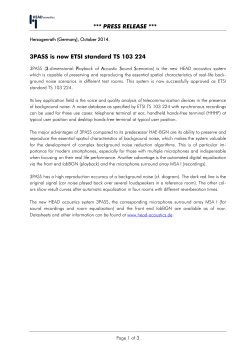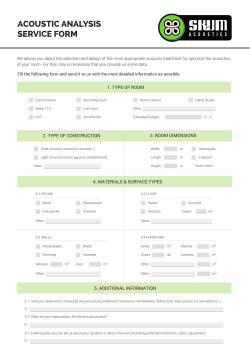
Presentation
Planning for Psychoacoustics: A Psychological Approach to Resolving Office Noise Distraction Presented by: Paige Hodsman, Concept Developer – Office Contents • Purpose of the report • Measuring sound • People and perceptions • Psychoacoustics • Worker Diversity • Practical solutions Purpose of the review • Needed to better understand a v. complex subject • Could physically measure; but couldn’t address other factors – more well-rounded approach • Teamed up with Nigel, lit review of nearly 200 research papers on people and sound • Precursor to solutions and intervention study Office Acoustic Measurements - UK Regs/Stds/Guidellines Key points Part E Resistance to the Passage of Sound BS8233:2014 room acoustics when attached to a residential dwelling, insulate and seek advice. Concentration: 35-45dB LAeq, Exec. 35-40 dB LAeq sound insulation Dw = 38 dB. Dw = 48 dB. reduction between wkstn15dB to 25dB (at 2.5m-3m distance), screens absorbent-facing and a minimum of 1.5m. A Class A rated ceiling is recommended on ceiling heights above 3m. Specific target measurements for open-plan offices, primary objective to reduce speech propagation and increase privacy Background noise level, STI, Absorption m3, physical factors, material selection, insulation, attenuation. Primarily material content, recyclability. Points awarded for addressing acoustics, no specific rec BS EN 3382-3/ISO 3382-3 AIS Guide to Office Acoustics, BCO Guide BREEAM, LEED, SKARating Office Acoustic Measurements - other countries Country Regulation or Standard Key points France France France HQE Label target 9 NF S 31-080 NF S 31-199 Floor surface for the performance Level Reverb Time and DL2 defines 4 types of activities. D2s, SPL in activity, Attenuation, RT RT and A/V depending on room type Germany DIN 18041 (Standard under revision) Germany VDI 2569 (guideline under development) Sweden SS25268 Netherlands DIN 18041/handboek bkk Nen 5077-2012 NPR 3438-2007 Poland PN-B-02151-4 D2S, LPAS4m, RT in diff. Classes depending on Activity RT 0.4 at 250-4000Hz Acoustic quality in small to medium-sized rooms Methods for performance on sound levels caused by technical services and RT Determination of the amount of disturbance of communication and concentration Acoustic absorption of the room referred to 1m2 of floor; 1.1 for open-plan office for general purposes and 1.3 for call centres Noise Causes Dissatisfaction Noise: • • Leesman Index (2014) Leesman Review Top 10 importance ~28% satisfaction Noise affects performance Source: Oseland and Burton (2012) Quantifying the impact of environmental conditions on worker performance People in the Office – WGBC It’s about People and our Senses Sounds becup.com • Physically • Psychologically • Physiologically hdwallpaperscool.com All sound clips from http://www.freesfx.co.uk/ Posted on 15 November 2009 by admin at http://harveysmuse.com/ Psychoacoustics is the scientific study of the psychological and physiological responses associated with sound What is noise? • “Noise is unwanted sound” – psychophysical issue • Physical sound level accounts for 25% variance, psychological 50% • Current focus is on physical not psychological Three primary areas of concern for office workers: • Lack of Control • Lack of Privacy • Disruptions from people talking Based on the research literature - four key non-physical factors affecting noise perception and performance: • Task and work activity • Perceived control & predictability • Context and attitude • Personality type Banbury, Berry, 2005– people, talking phones, unable to habituate Exploring Diversity in the workplace… Task & personality Task & personality Personality type Nature of task Introvert Simple Complex Extrovert Simple Complex Quiet Noisy Practical Solutions Challenges in open plan spaces Screen height and absorption – if I can see your mouth moving, I can hear you! We‘re a busy team here, making lots of noise....we‘re happy Insulation – controls disturbances from room to room Speech propagation diminishes with distance, ceiling absorption and barriers…we’re happy Dedicated quiet areas, away from open plan Good acoustic design should….. …contribute to a good working environment which promotes both wellbeing and performance; – Enhance communication within teams – Reduce disturbance/distraction from unwanted speech – Improve speech privacy – Support employees working on concentrated or complex tasks – Aid productivity – Ultimately sustainable People-centred approach… • Displace – access to separate collaboration spaces, adequate quiet rooms, working from home, visual cues library vs café • Avoid – speaker phones and meeting tables in open-plans requiring concentration. Noisy vs quiet teams, personality map (intro vs extro) • Reduce – control density/desk size (too many, too noisy), good absorbing and insulating materials, soundscape rather than sound masking • Educate – acoustic etiquette – loud talking, interruptions, ring tones, do not disturb signals The Acoustic Layer: Adjacencies Material Selection Furniture placement Physical Acoustics On-line Acoustic Survey – Pre and Post Occupancy Design and Specification OCEAN Test Introvert/ Extrovert Subjective Acoustic Psychological Profile The Broader Acoustic Solution Modelling POE: ISO 3382-3 D2S and Lp,A,S,4 m STI Call to Action and Questions Email: paige.hodsman@ecophon.co.uk Visit: www.ecophon.co.uk Follow us on twitter: @ecophonuk
© Copyright 2025


















